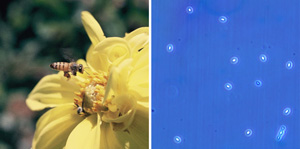Molecular basis of genome interaction of the honeybee Apis mellifera with an evolutionary old and novel introduced Nosema species
Professor Dr. Robin F. A. Moritz
Professor Dr. Robert John Paxton
PhD Student:
Professor Dr. Robin F. A. Moritz
Professor Dr. Robert John Paxton
PhD Student:

We use the honeybee, Apis mellifera, and its microsporidian parasite, Nosema as a model system to study host-parasite co-evolution in a social insect species. In the previous funding period, we could map a single QTL to chromosome 14 which reduced the parasite spore load in the host gut in a strain of Danish honeybees, which had been selected for Nosema resistance. The QTL was independently confirmed by a selective sweep in the identical chromosome region, comprising only four open reading frames. Two of these genes are prime candidates for resistance mechanisms against Nosema infections. One gene is part of the RNAi machinery and the other engages with the innate insect immune system. In the forthcoming period we want to study how the parasite genome negotiates with host defence genes.
We will screen for patterns of selection in the pathogen genome in two different Nosema species using artificial evolution experiments, using both the animal host and a model insect cell culture system as host. Nosema will be selected for high and low virulence in the resistant and the susceptible honeybee strain and in the cell culture system. RNAi will be used to knock down gene expression of the cell culture system to mimic selection in a susceptible host. Using drones produced by a hybrid queen that is heterozygote for the susceptibility and the resistance allele, we will screen for interactions at the host/pathogen transcriptome level and also assess the importance of phenotypic plasticity in pathogen virulence for host-parasite co-evolution after artificial selection for high and low virulence. Results will highlight the degree of genetic adaptability the parasite can exhibit under selection for virulence, as opposed to phenotypic plasticity for virulence. They will also reveal common genetic factors that mediate Nosema virulence, and show how quickly host-pathogen systems can co-evolve. Finally, results will also inform us of the gene cascades and physiological pathways that have been affected by selection of host resistance in the first place, which could point to conserved cellular defence mechanisms.